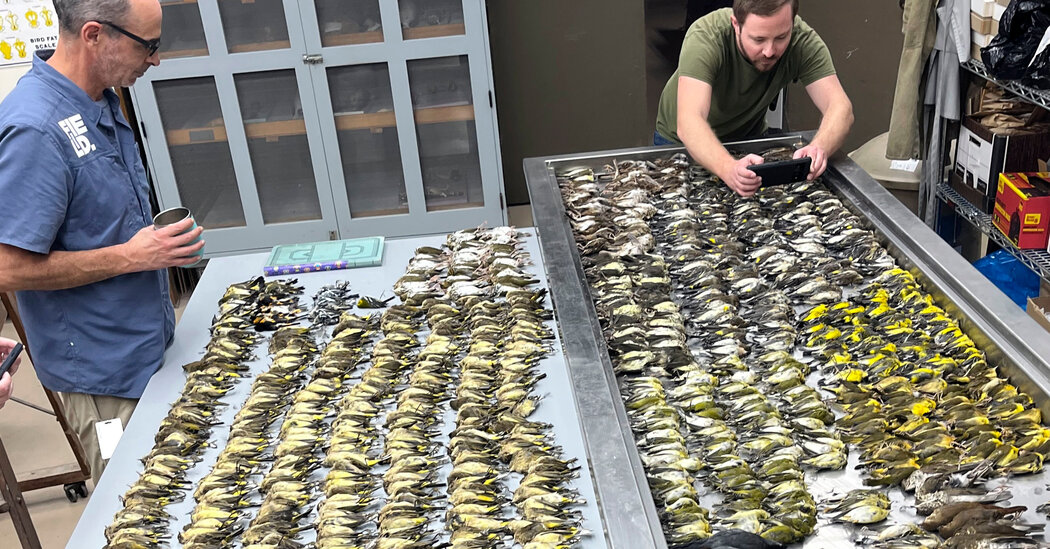Some California Counties Ban River Recreation Because of Dangerous Conditions
Gwyny Pett has been visiting the Kern River for decades, camping there as a girl and then taking her own children, now grown, to splash in shallows so calm they felt like a private pool. She has seen it in dry cycles like last year, when the river was difficult to explore not because of surging water, but because she turned her ankles on the exposed pebbles.
She has also seen the destructive power of the river during high-water years. And although Ms. Pett, 66, recently looked ready for a swim at a popular riverside campground — black bikini on, pool towel draped over her beach chair — there was no way she was getting in.
“I mean, this is dangerous,” she said, gesturing at the water speeding past.
After a parade of epic winter storms, the Kern River and other major waterways fed by melting Sierra Nevada snow have become wild torrents — a transformation so dangerous that several counties in Central California have prohibited people from entering the water.
Since April, at least 16 people have died or gone missing in rivers across the state, according to The Mercury News, including two young siblings who were swept away on the Kings River in Fresno County in May. On Wednesday, a kayaker died on the Kern River, about 20 miles upstream from the campground from where Ms. Pett was sitting.
“There is a historic amount of water right now: faster, colder and more deadly than we’ve seen in recent years,” said Brian Ferguson, a spokesman for the Governor’s Office of Emergency Services. “There is no amount of training or exercise that prepares a human body.”
In the Central Valley and Sierra Nevada foothills, river swimming holes and rafting trips are a way of life each summer. The snowmelt-infused water can feel like nature’s gift to inland residents who must cope with sweltering heat without the benefit of ocean breezes.
But people die every year because they underestimate the currents they cannot see, often without wearing life jackets or knowing how to swim. This year, officials are warning everyone to take heed, especially those who have safely dipped in a river during normal years and may feel overconfident.
“During Covid, a lot of people found the outdoors,” said Mike Howard, the superintendent for the Auburn State Recreation Area, which includes two forks of the American River about 35 miles northeast of Sacramento. “But as they come to their favorite spot in June or on the Fourth of July, where swimming was relatively safe last year, this year is going to be very different.”
So far, at least three people have drowned on the American River this year. Mr. Howard said that the state recreation area now has swift water lifeguards at some areas, but the currents are too unsafe for them to swim after a visitor in distress.
“We’re very focused on prevention,” he said.
In Fresno County, as waters rose in March, officials closed the Kings and San Joaquin Rivers to anyone except professional rafting companies and threatened violators with $225 fines. Tony Botti, a spokesman for the Fresno County Sheriff’s Office, said that compliance has been high.
“Unfortunately, the tragedy of losing two children really woke them up,” Mr. Botti said. “It’s life over recreation.”
On Friday, Sheriff John Zanoni of Fresno County announced that his office was reopening the San Joaquin River because of lower water levels, but the Kings remained closed.
The Kern River has a reputation as a tempestuous beauty — an alluring playground for rafters and kayakers (its north fork is one of the steepest white water rivers in North America) but potentially treacherous for those unable to resist.
Mothers in Bakersfield forbid their children from diving in, lest they be swept away. Merle Haggard, the region’s pre-eminent troubadour, vowed in a song that he would “never swim Kern River again” after a lover drowned in its waters. A famous sign near the mouth of a winding canyon road to campgrounds and Kernville, an Old West-inflected town that serves as a base for river recreation, displays a grim tally: “325 LIVES LOST SINCE 1968.”
It is updated annually.
The Kern River originates near Mount Whitney, the highest point in the contiguous United States, and winds through Tulare County before it meanders into Kern County down to the valley floor, and through Bakersfield. At the river’s northern end, Sheriff Mike Boudreaux of Tulare County has officially restricted access to the water to anyone except commercial outfitters. But his counterpart to the south in Kern County, Sheriff Donny Youngblood, has not.
Lori Meza, a spokeswoman for the Kern County Sheriff’s Office, said that a swimming ban would be too difficult to enforce because of the number of agencies and property owners that would have to be involved. But she said the department has worked to spread the word: Wear a life jacket if you are anywhere near the water. Know where you have cell service in case you need to call for help.
In the past, such warnings largely have not made their way to Los Angeles, where many weekend travelers see the Kern as an affordable road trip without understanding the risks; the river is within a four-hour drive of more than a third of Southern California’s population.
On a recent morning, Zac Boyd, a Kern County fire captain who is an expert in swift water rescues, explained how campers who do not intend to swim are often drawn toward the water. Without realizing the granite rocks are slick, they can slip into a powerful current if they lose their footing. Children allowed to play too close to the edge can disappear instantly.
Mr. Boyd said few can turn their attention away from the water, “almost like a car crash.”
The worst dangers may be yet to come. Temperatures have been cooler than normal this spring across California, leaving more snow in the mountains than was expected in mid-June. Assuming that summer temperatures will tick above their normal 100 degrees even at higher elevations, major snow melts are expected in the coming weeks.
Not far from where Ms. Pett lounged in the shade at Sandy Flat Campground, newer campers said they had heard the warnings and were content to bear witness to the river’s revival.
“I’m glad to hear the snowpack is back to where it needs to be,” said Hamilton Cerna, 41, who had come from Long Beach with his family. “If that means we can’t go into the river, then so be it.”
Still, the raging waters are proving irresistible to some thrill seekers.
From a perch overlooking churning white water rapids, Augie Houlemard, 29, the general manager of Kern River Outfitters, watched as the first of three rafts full of his guides careened as it went over a boulder obscured by a cascade of water.
“He got a big chunk of that,” Mr. Houlemard remarked. The other two rafts passed. “That was good!” he said, smiling.
When he and his colleagues are not guiding rafting expeditions, they are training to safely lead visitors, scoping out where hazards may have emerged and practicing their routes. When they are not on the water themselves, they are obsessively tracking the river’s flow, debating when it will peak and where conditions are best to launch a boat.
“People are still talking about 2019, and 2019 was big,” he said. “But not even close to this.”


